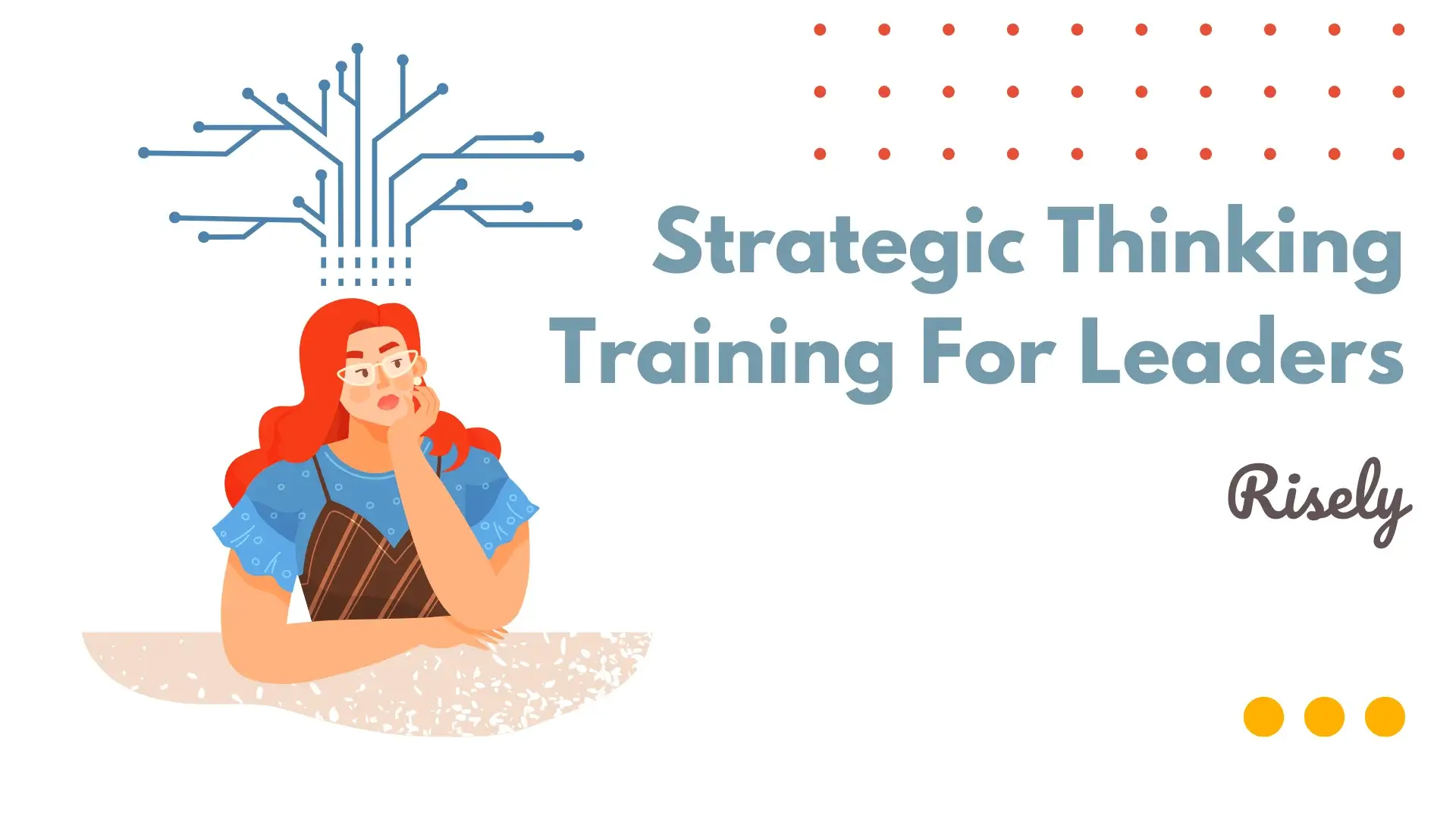8 Strategic Thinking Examples to Help You Succeed
Strategic thinking is an essential skill that leaders and managers must possess to steer their teams toward success. It involves analyzing situations, identifying opportunities and risks, and developing innovative solutions that align with the organization’s goals and objectives. This blog will explore the success stories and failures of strategic thinking in various industries and contexts. We will highlight some real-world strategic thinking examples of companies and leaders who have succeeded due to strategic thinking and examine some instances where a lack of strategic thinking has led to failure. By exploring these strategic thinking examples, we aim to provide valuable insights and inspiration to enhance your strategic thinking skills and drive growth and success in your team. So explore some of the most inspiring strategic thinking examples of strategic thinking in action, including success stories and cautionary tales!- 8 Strategic Thinking Examples to Help You Succeed
- What is strategic thinking?
- Why is strategic thinking important in the workplace?
- Real-life Examples of Successful Strategic Thinking
- Understanding Successful Strategic Thinking Mindset with Scenarios
- Real-life Examples of Failed Strategic Thinking
- Understanding what leads to failed strategic thinking with scenarios
- Conclusion
- FAQs
- Other Related Blogs
What is strategic thinking?
Strategic thinking is the ability to analyze complex situations, consider multiple possible courses of action, and develop and execute a plan to achieve long-term goals. It involves taking a holistic view of the team and its external environment, understanding the strengths and weaknesses of the team, and identifying opportunities and threats. Strategic thinking also requires a deep understanding of the market, competition, and industry trends and the ability to anticipate changes and adapt to them.Why is strategic thinking important in the workplace?
Strategic thinking is important in the workplace for several reasons:- Setting direction: Strategic thinking helps teams to set a clear direction for the future. By understanding the external environment and the team’s internal strengths and weaknesses, strategic thinkers can develop a roadmap for achieving long-term goals.
- Identifying opportunities: Strategic thinking enables teams to identify new opportunities and potential threats. Strategic thinkers can anticipate changes and develop strategies to capitalize on emerging opportunities by analyzing market trends and competitive landscapes.
- Resource allocation: Strategic thinking helps teams to allocate their resources effectively. By prioritizing initiatives and investments based on their strategic importance, teams can ensure that resources are allocated to the most critical areas.
- Collaboration: Strategic thinking promotes collaboration and teamwork. By involving employees in strategic planning, teams can foster a shared sense of purpose and engage employees in the team’s mission.
Real-life Examples of Successful Strategic Thinking
Strategic Thinking Example # 1:
Apple: Apple is a technology giant known for its iconic products like the iPhone, iPad, and MacBook. The company has succeeded due to its focus on product design, innovation, and customer experience. Apple has also built a loyal customer base by prioritizing quality over quantity and creating a seamless ecosystem of products and services.Strategic Thinking Example # 2:
Nike: Nike is a global athletic footwear and apparel leader. The company succeeded due to its strategic brand positioning, emphasizing high-performance products, innovative design, and celebrity endorsements. Nike has also invested heavily in marketing and advertising, focusing on social media and experiential marketing campaigns. Both companies have succeeded due to their innovative business models, focus on customer needs, investment in emerging technologies, and strategic marketing and branding efforts. They have also adapted to changing market conditions and trends while staying true to their core values and mission.Other Interesting Reads
Understanding Successful Strategic Thinking Mindset with Scenarios
Strategic Thinking Example #1
A team leader did not have a clear strategy for achieving specific business goals but instead focused on creating a positive and supportive work environment for team members. As a result, the team achieved high levels of performance and productivity due to their strong sense of camaraderie and shared purpose. Here are the lessons that can be learned from the examples of strategic thinking skills:- Employee engagement is critical to team performance: Employee engagement is a key driver of team performance and productivity, and managers should prioritize creating a positive and supportive work environment.
- Employee satisfaction leads to better results: Employees who feel valued and engaged are more likely to be satisfied with their work and deliver better results.
- Purpose and meaning are important motivators: Employees are motivated by having a sense of purpose and meaning in their work, and managers should strive to connect team members with the broader goals and mission of the organization.
- A supportive leader is key: A supportive leader who is empathetic, approachable, and empowering can create a positive and productive work environment that inspires team members to perform at their best.
Strategic Thinking Example # 2
A sales manager did not have a clear sales strategy but instead relied on personal customer relationships to drive sales. As a result, the manager generated significant revenue by building trust and rapport with customers. Here are the learnings and strategic thinking used by the manager who relied on personal relationships with customers to drive sales:- Emphasize customer experience: Providing excellent customer service, and a positive experience can lead to repeat business and referrals.
- Personalize the approach: Understanding each customer’s unique needs and preferences, and tailoring the approach accordingly, can help build stronger relationships and drive sales.
- Leverage word-of-mouth marketing: Satisfied customers can be powerful advocates for a business, and word-of-mouth marketing can help drive sales and generate new leads.
- Prioritize customer retention: It can be more cost-effective to retain existing customers than acquire new ones, so managers should prioritize building long-term customer relationships.
Real-life Examples of Failed Strategic Thinking
Strategic Thinking Example # 1
Motorola: Motorola was a dominant player in the mobile phone industry during the early 2000s but failed to keep up with changing market trends and competition from new players like Apple and Samsung. The company failed to adopt a cohesive strategy for smartphone development and struggled to keep pace with competitors regarding innovation and product development. This led to a decline in market share and, ultimately, the sale of Motorola’s mobile phone division to Google in 2012.Strategic Thinking Example #2
Kodak: Kodak was a market leader in the photography industry for over a century but failed to adapt to the rise of digital photography. The company strongly focused on traditional film-based photography and should have invested in digital technology, despite inventing the first digital camera. When Kodak began to pivot towards digital photography, it was too late, and the company declared bankruptcy. In both cases, the companies failed to anticipate and adapt to changes in the market and neglected to prioritize innovation and product development. They also failed to adopt a cohesive and proactive strategic plan, ultimately leading to their downfall.Understanding what leads to failed strategic thinking with scenarios
Strategic Thinking Example # 1
A retail manager who failed to adapt to changing consumer preferences: The clothing store manager could not recognize the shift towards online shopping and did not invest in e-commerce capabilities. As a result, the store lost market share to competitors with a stronger online presence. e Here are the learnings that can be learned from the strategic thinking examples:- Keep up with changing consumer preferences: Managers must stay current with changing consumer preferences and trends to remain competitive.
- Adapt to new technologies: Managers must be willing to adapt to new technologies and embrace innovation to stay ahead of the competition.
- Be proactive, not reactive: Managers should be proactive in anticipating changes in the market and taking steps to adapt rather than waiting until it is too late.
- Listen to customer feedback: Managers should listen to customer feedback and use it to inform their decision-making and strategy.
- Continuously improve: Managers should constantly seek ways to improve their business and stay relevant to customers.
Strategic Thinking Example # 2
A project manager who failed to communicate effectively with stakeholders: A project manager failed to communicate with stakeholders and did not provide regular updates on the project’s progress. This lack of communication led to misunderstandings and delays. Here are the learnings that can be learned from the strategic thinking examples:- Establish clear communication channels: Managers should establish clear communication channels and protocols for informing stakeholders of project progress.
- Listen actively: Managers should listen to stakeholder feedback and concerns and use this feedback to inform decision-making and project planning.
- Develop a stakeholder engagement plan: Managers should develop a stakeholder engagement plan that outlines the key stakeholders, their interests, and their communication preferences.
- Be responsive: Managers should respond to stakeholder inquiries and concerns and promptly and proactively address any issues.
Conclusion
In conclusion, strategic thinking is crucial for leaders and managers in today’s rapidly changing business landscape. By analyzing real-world strategic thinking examples of both success and failure, we can learn valuable lessons about the importance of strategic thinking and the potential consequences of neglecting it. Strategic thinking enables organizations to thrive and achieve their goals, whether focusing on innovation, prioritizing customer needs, or adapting to changing market conditions. By developing and honing our strategic thinking skills, we can help our organizations navigate challenges, capitalize on opportunities, and drive success. So let’s embrace strategic thinking and continue to learn from the inspiring strategic thinking examples around us!Can you solve major team problems with your strategic thinking skills?
Take Risely’s free problem solving assessment now to know in just a few minutes.
FAQs
How do you show strategic thinking?
You can show strategic thinking by demonstrating your ability to consider long-term goals, anticipate potential challenges and opportunities, and develop innovative solutions that align with organizational objectives.
What are some strategic thinking skills?
Some strategic thinking skills include critical thinking, problem-solving, creativity, adaptability, communication, and decision-making.
What are examples of strategic decisions?
Strategic decisions include
– launching new products or services
– investing in new technology
– acquiring or merging with other companies
– launching new products or services
– investing in new technology
– acquiring or merging with other companies
How do you apply strategic thinking?
To apply strategic thinking, you can start by clarifying the team’s goals and objectives, analyzing the external environment and internal capabilities, identifying potential risks and opportunities, and developing a plan of action that aligns with the overall strategy. It’s also essential to continuously monitor and adjust the strategy to ensure ongoing success.
Other Related Blogs
Strategic Thinking Training For Leaders Simplified
Strategic Thinking Training For Leaders Simplified Strategic thinking is a vital skill for business leaders, managers, and employees in today’s fast-paced, competitive world. It goes beyond day-to-day tasks and involves…
10 Best Strategic Thinking Coaches to Speed Up Your Growth
10 Best Strategic Thinking Coaches to Speed Up Your Growth In the fast-paced and ever-evolving business landscape, strategic thinking has become more than just a desirable trait; it’s a critical…
5 Powerful Skills to Become an Exceptional Business Leadership Coach
5 Powerful Skills to Become an Exceptional Business Leadership Coach In the world of business, leadership is of paramount importance. It is something that makes all the difference. With so…
Strategic Thinking In Leadership: Secrets To Success From 5 Leaders
Strategic Thinking In Leadership: Secrets To Success From 5 Leaders Leadership is more than just managing people and resources. It’s about having a vision for the future and developing a…


